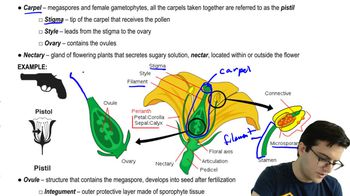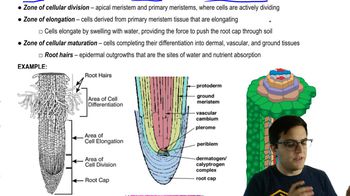Table of contents
- 1. Introduction to Biology2h 42m
- 2. Chemistry3h 40m
- 3. Water1h 26m
- 4. Biomolecules2h 23m
- 5. Cell Components2h 26m
- 6. The Membrane2h 31m
- 7. Energy and Metabolism2h 0m
- 8. Respiration2h 40m
- 9. Photosynthesis2h 49m
- 10. Cell Signaling59m
- 11. Cell Division2h 47m
- 12. Meiosis2h 0m
- 13. Mendelian Genetics4h 44m
- Introduction to Mendel's Experiments7m
- Genotype vs. Phenotype17m
- Punnett Squares13m
- Mendel's Experiments26m
- Mendel's Laws18m
- Monohybrid Crosses19m
- Test Crosses14m
- Dihybrid Crosses20m
- Punnett Square Probability26m
- Incomplete Dominance vs. Codominance20m
- Epistasis7m
- Non-Mendelian Genetics12m
- Pedigrees6m
- Autosomal Inheritance21m
- Sex-Linked Inheritance43m
- X-Inactivation9m
- 14. DNA Synthesis2h 27m
- 15. Gene Expression3h 20m
- 16. Regulation of Expression3h 31m
- Introduction to Regulation of Gene Expression13m
- Prokaryotic Gene Regulation via Operons27m
- The Lac Operon21m
- Glucose's Impact on Lac Operon25m
- The Trp Operon20m
- Review of the Lac Operon & Trp Operon11m
- Introduction to Eukaryotic Gene Regulation9m
- Eukaryotic Chromatin Modifications16m
- Eukaryotic Transcriptional Control22m
- Eukaryotic Post-Transcriptional Regulation28m
- Eukaryotic Post-Translational Regulation13m
- 17. Viruses37m
- 18. Biotechnology2h 58m
- 19. Genomics17m
- 20. Development1h 5m
- 21. Evolution3h 1m
- 22. Evolution of Populations3h 52m
- 23. Speciation1h 37m
- 24. History of Life on Earth2h 6m
- 25. Phylogeny2h 31m
- 26. Prokaryotes4h 59m
- 27. Protists1h 12m
- 28. Plants1h 22m
- 29. Fungi36m
- 30. Overview of Animals34m
- 31. Invertebrates1h 2m
- 32. Vertebrates50m
- 33. Plant Anatomy1h 3m
- 34. Vascular Plant Transport1h 2m
- 35. Soil37m
- 36. Plant Reproduction47m
- 37. Plant Sensation and Response1h 9m
- 38. Animal Form and Function1h 19m
- 39. Digestive System1h 10m
- 40. Circulatory System1h 57m
- 41. Immune System1h 12m
- 42. Osmoregulation and Excretion50m
- 43. Endocrine System1h 4m
- 44. Animal Reproduction1h 2m
- 45. Nervous System1h 55m
- 46. Sensory Systems46m
- 47. Muscle Systems23m
- 48. Ecology3h 11m
- Introduction to Ecology20m
- Biogeography14m
- Earth's Climate Patterns50m
- Introduction to Terrestrial Biomes10m
- Terrestrial Biomes: Near Equator13m
- Terrestrial Biomes: Temperate Regions10m
- Terrestrial Biomes: Northern Regions15m
- Introduction to Aquatic Biomes27m
- Freshwater Aquatic Biomes14m
- Marine Aquatic Biomes13m
- 49. Animal Behavior28m
- 50. Population Ecology3h 41m
- Introduction to Population Ecology28m
- Population Sampling Methods23m
- Life History12m
- Population Demography17m
- Factors Limiting Population Growth14m
- Introduction to Population Growth Models22m
- Linear Population Growth6m
- Exponential Population Growth29m
- Logistic Population Growth32m
- r/K Selection10m
- The Human Population22m
- 51. Community Ecology2h 46m
- Introduction to Community Ecology2m
- Introduction to Community Interactions9m
- Community Interactions: Competition (-/-)38m
- Community Interactions: Exploitation (+/-)23m
- Community Interactions: Mutualism (+/+) & Commensalism (+/0)9m
- Community Structure35m
- Community Dynamics26m
- Geographic Impact on Communities21m
- 52. Ecosystems2h 36m
- 53. Conservation Biology24m
33. Plant Anatomy
Growth
Problem 5`
Textbook Question
Suppose a flower had normal expression of genes A and C and expression of gene B in all four whorls. Based on the ABC hypothesis, what would be the structure of that flower, starting at the outermost whorl?
a. Carpel-petal-petal-carpel
b. Petal-petal-stamen-stamen
c. Sepal-carpel-carpel-sepal
d. Sepal-sepal-carpel-carpel
 Verified step by step guidance
Verified step by step guidance1
Understand the ABC model of flower development: The ABC model explains how the identity of floral organs is determined by the expression of three classes of genes: A, B, and C. Each gene class is responsible for the development of specific whorls in the flower.
Identify the role of each gene class: Gene A is responsible for sepals, Gene B for petals and stamens, and Gene C for stamens and carpels. The combination of these genes determines the identity of the floral organs in each whorl.
Analyze the given gene expression: The problem states normal expression of genes A and C, and expression of gene B in all four whorls. This means gene A is expressed in the first whorl, gene B in all whorls, and gene C in the third and fourth whorls.
Determine the structure of each whorl: Based on the ABC model, the first whorl with gene A expression will form sepals. The second whorl with gene A and B expression will form petals. The third whorl with gene B and C expression will form stamens. The fourth whorl with gene C expression will form carpels.
Match the structure to the options: The sequence of floral organs from outermost to innermost whorl is sepal-petal-stamen-carpel. Compare this sequence with the given options to identify the correct answer.
 Verified video answer for a similar problem:
Verified video answer for a similar problem:This video solution was recommended by our tutors as helpful for the problem above
Video duration:
48sPlay a video:
Was this helpful?
Key Concepts
Here are the essential concepts you must grasp in order to answer the question correctly.
ABC Model of Flower Development
The ABC model explains how the identity of floral organs is determined by the expression of three classes of genes: A, B, and C. Class A genes specify sepals, A and B together specify petals, B and C specify stamens, and C alone specifies carpels. This model helps predict the arrangement of floral organs based on gene expression patterns.
Recommended video:
Guided course

Flower Anatomy
Gene Expression in Floral Whorls
Floral organs are arranged in concentric whorls, typically four: sepals, petals, stamens, and carpels. The expression of specific genes in these whorls determines the type of organ formed. In the ABC model, the presence or absence of gene expression in each whorl dictates the organ identity, crucial for understanding flower structure.
Recommended video:
Guided course

Introduction to Regulation of Gene Expression
Mutations and Gene Expression Patterns
Mutations affecting gene expression can alter the normal pattern of floral organ development. In the given scenario, the expression of gene B in all whorls suggests a mutation or alteration from typical expression patterns, leading to a change in organ identity. Understanding these patterns is essential for predicting the resulting flower structure.
Recommended video:
Guided course

Introduction to Regulation of Gene Expression
Related Videos
Related Practice






















